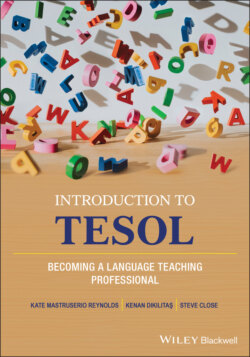Читать книгу Introduction to TESOL - Kate Reynolds - Страница 20
Differentiating the focus from language teaching to preparing language teachers
ОглавлениеAnyone who has tried to look up teaching English by “ESL” will be familiar with the difficulties associated with the use of ESL versus TESL or EFL versus TEFL. Not only do they look similar, but also their meanings are sometimes confused. Generally, if it has a “T” at the beginning of the acronym, it means teaching English as a second/foreign language (TESL/TEFL) and is used to describe the preparation to become a teacher of ESL/EFL. The emphasis is on the teaching of the subject. Applying this rule, the acronym “TESOL” then indicates teaching or teachers of English to speakers of other languages. Two professional organizations, TESOL International Association (www.tesol.org) and International Association of Teachers of English as a Foreign Language (IATEFL) (www.iatefl.org), have the T in their acronyms, but are used to describe the processes of teaching and learning of English in differing contexts.
Another common acronym for teacher preparation is ELT for English language teaching. This term is often employed in the United Kingdom and other countries closely associated with Britain; for example, countries in the European Union and former colonies of Britain, such as Hong Kong and India. ELT is used as an inclusive term, which does not highlight context. It is considered an overarching term, which is a positive characteristic. Another positive characteristic is that the use of it reduces all of the acronyms. A con for the use of the term is that it is not precisely descriptive for insiders.
In some contexts, you may observe the use of TESOL or Applied Linguistics employed interchangeably. The reasons that these terms can be used interchangeably stem from the early emergence of the field in 1946. As the field was beginning to be established and was initially defining itself, it was concerned with research-based foreign language teaching (including English to nonnative speakers) (https://www.linguisticsociety.org/resource/applied-linguistics). The field has continued to define itself and the parameters of study. Currently, according to the Association Internationale de Linguistique Appliquée (n.d.) or International Association of Applied Linguistics, the field of “Applied Linguistics is an interdisciplinary and transdisciplinary field of research and practice dealing with practical problems of language and communication that can be identified, analyzed or solved by applying available theories, methods and results of Linguistics or by developing new theoretical and methodological frameworks in Linguistics to work on these problems” (https://aila.info). In other words, the fields share interests in research on both second/additional language acquisition/learning and language teaching.
One minor difference between TESOL and Applied Linguistics is that TESOL focuses on English, whereas Applied Linguistics is concerned with the learning/acquisition of any second or additional language. For example, learning Italian in Italy if you do not speak Italian as a native speaker.
While it may appear overwhelming to newcomers to have so many diverse acronyms, their use has a practical application. The various acronyms help identify the population and context of instruction. They also indicate an orientation to the field to be inclusive and representative of learners and their backgrounds. It is best considered as shorthand or code for simplifying discussions among colleagues.
